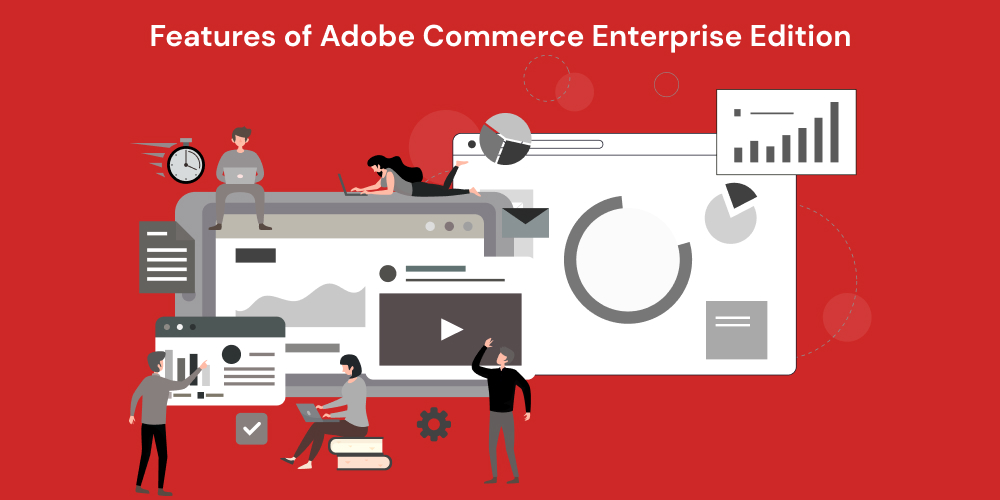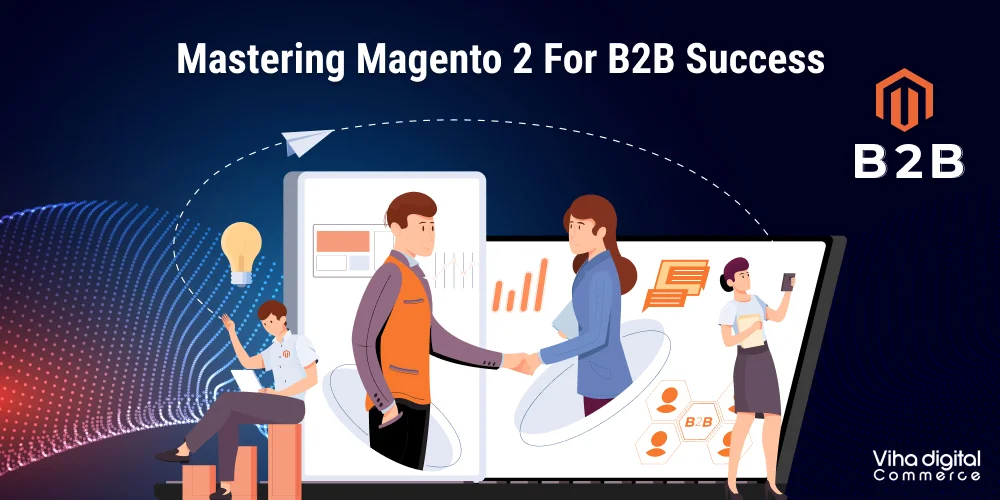
Enterprise level eCommerce features in Magento Adobe Commerce
Adobe commerce, which is powered by Magento, includes a variety of eCommerce features that assist Magento merchants in Magento Speed Optimization. The most important features of Enterprise-level Adobe Commerce are listed below.
- Excellent user experiences
- Multi-brand
- Mobile-centric Approach
- B2B Integration
- Intelligence and insight tools
- Marketing
- Order management system
- Cloud-based assistance
- Customer management
- Omnichannel and multisite
- Headless Commerce
- Selling on Amazon
- Page Builder
- Live Search
- Inventory Management
- Cutting-edge shopping experiences
- Delivery Solutions
- Business Intelligence
- Visualizations and Reports
- Payment

1. You can provide excellent user experiences to your customers:
Customers will be able to shop whenever they want, from anywhere. Using Adobe Commerce, you can easily connect shopping experiences across channels, add new brands and sites, expand into new geographies, and sell to businesses and consumers.
2. Multi-brand solution:
Regardless of the audience, the same excellent buying experience is provided.
Just because you sell to different audiences does not necessitate the use of multiple systems to run your online stores. Magento Enterprise Development allows you to manage all of your content and products, whether you manage multiple brands, sell in multiple countries, or use different business models.
You can use it to set different pricing structures, present different products to different audiences, and customize the checkout and fulfillment process. It’s entirely up to you.
Regardless of your audience, you can keep all of your brands together by not switching platforms, hiring or training additional staff, or changing partners.
3. A Mobile-centric Approach:
Progressive web applications (PWAs), that are using the browser’s capabilities to provide an immersive experience, provide a mobile app-like experience.
Businesses can create engaging mobile commerce experiences with Magento PWA Development Services. Merchants can use a PWA to enhance consumer engagement, conversion rates, and revenue.
4. B2B Integration:
Your customers can manage their accounts online thanks to Adobe Commerce’s (Magento) integrated B2B capabilities. By establishing multiple levels of buyers with permissions and roles, tracking quotes and orders, establishing rules for purchase approval, and managing their credit online, you can make the day-to-day management tasks for your customers more efficient.
The purchasing experience is personalized with customized catalogs and pricing, as well as targeted content and promotions. Convenience is at the heart of the Magento Enterprise platform, with quick order forms, saved shopping lists, and the ability to request quotes whenever necessary. A seller-assisted shopping experience takes it a step further, allowing you to place orders on behalf of customers and troubleshoot issues, facilitating a frictionless customer experience that increases sales.
5. Intelligence and insight tools for business
Data can be used to uncover patterns and insights into customer behavior. You can use customer browsing and purchase data when you monitor your eCommerce window. To expand your offering, understand what’s popular and what your customers want.
6. Marketing automation and promotions
Create marketing materials, promotional offers, and other promotional offers that are aimed at both former customers and new prospects. You can reach out to your target audience with useful and valuable content by utilizing an automated marketing system.
7. An easy-to-use order management system
With a good eCommerce platform, the order process will be seamless. Consider providing on-demand support to your B2B buyers through e-chat sales reps or a chatbot.
Your platform should allow you to track orders as soon as they enter the funnel, as well as track quotes, orders, and invoices.
8. Cloud-based assistance is available.
A scalable, cloud-based support system is a necessary component of B2B eCommerce. It is far more cost-effective to host your eCommerce platform in the cloud rather than on-premises.
9. Individualized customer management
Using a personalized customer management system, you can create customized customer communications. Building long-term relationships are critical to the success of any business – happy customers convert more frequently.
Personalization distinguishes your company from the competition and makes your customers feel valued. Customize each customer’s shopping experience by using customer management tools to ensure that they get exactly what they need every time.
10. Offer omnichannel and multisite support.
In this day and age, your brand must be present everywhere, from your website to customer interactions and support. Integrating an eCommerce platform will make it easier to manage your omnichannel presence while automating where possible. If you are marketing globally, a leading eCommerce solution will provide multi-national site offerings as well as support for multiple languages.
In addition, you can manage and edit pages across multiple sites from a single location. The next time you need to raise a product price, there will be no need for manual editing across multi-nation pages.
11. Headless Commerce:
API-based commerce is quick, agile, and adaptable, allowing you to provide consistent experiences to your customers across all channels and devices.
Headless allows developers to work independently on both the front-end and back-end architectures by decoupling them. With over 500 Rest and GraphQL operations available from a single backend, you can run the various sites your customers interact with while using Adobe Commerce. Furthermore, the headless platform integrates with Adobe tools and third-party front ends, resulting in rich, connected, and accessible commerce experiences.
12. Selling on Amazon
Deliver multichannel commerce experiences to B2B and B2C customers from a single platform. You can use our future-proof technology to create a commerce platform that is flexible, extensible, and scalable from the catalog to payment to fulfillment.
13. A captivating user experience
Make your commerce vision a reality with an eCommerce solution that combines powerful out-of-the-box features, unrivaled customizability, and seamless third-party integration.
14. Page Builder:
Page Builder Create and launch new content to provide best-in-class, personalized shopping experiences on your site.
Customers expect tailored experiences, so Adobe Commerce has made it easier than ever to create customized content with integrated customer segmentation tools. With a single click, you can add relevant and engaging Product Recommendations to your site and further engage your audience.
15. Live Search:
When customers use site search, they are much more likely to purchase something. Despite the fact that many shoppers browse online, they do not use navigation – instead, they use keywords, and categories, and search for relevant results to help them find what they’re looking for. Merchants, on the other hand, typically have to spend hours manually entering backend rules and making educated guesses in order to surface the “just right” thing.
Everything changes with Live Search. By combining Adobe Sensei with catalog data, merchants can provide lightning-fast search results and personalized responses to every shopper query. Merchants can use Sensei to identify facets for each query, saving time on manual rules.
16. Order and Inventory Management:
Businesses with multiple brands, sites, shops, and warehouses can create seamless cross-channel commerce experiences with Adobe Commerce (Magento) inventory and order management.
Fulfillment options and sourcing algorithms make it simple to find the closest location to a customer’s order and meet their needs. Furthermore, real-time sourcing methods enable more accurate global inventory management.
17. You can improve omnichannel fulfillment.
With BOPIS (buy-online-pickup-in-store), you can allow your customers to select the most convenient pickup option for them, making BOPIS easier to manage for store employees and providing better visibility into your stores’ moving inventory.
Store employees can accurately pick orders placed online for in-store or curbside delivery using an employee picking app.
- Using the employee order handoff app, store employees can quickly hand off orders to customers, reducing wait times.
- Customers can easily see what’s available in-store online, which is critical for attracting online customers to physical locations.
- Merchants can improve the accuracy of their stock information by updating stock information after the fulfillment source has been defined.
18. Creating cutting-edge shopping experiences with Adobe Commerce:
Shoppers today are mobile device-dependent, and they expect to be drawn to and directed by their mobile devices. By providing fast, engaging, and app-like browsing experiences, the PWA concept is redefining how consumers interact with their mobile devices.
With Adobe Commerce’s PWA studio, you can assist merchants in gaining new customers, increasing conversion rates, improving search rankings, and lowering development costs. PWAs can load content quickly across any network thanks to performance-optimized and responsive design strategies, resulting in a consistent user experience across desktop, tablet, and smartphone devices.
19. Managing Customer Accounts:
With Adobe’s order management capabilities, your team has access to all of the tools and information it requires in one place, including real-time inventory views, centralized order information, and the ability to generate returns and refunds. Adobe Commerce makes every interaction easier, faster, and more memorable through centralized real-time information.
20. Delivery Solutions:
Adobe Commerce merchants can integrate their storefronts with ShopRunner (US only), one of the leading eCommerce platforms and a subsidiary of FedEx Services. Merchants will benefit from this integration by being able to deliver packages within two days and provide seamless checkout and return experiences.
21. Measuring and optimizing User Experience:
With insights and tools that make the shopping experience more relevant, you can personalize it in real time. You can also create custom dashboards and business reports without the help of IT.
22. Business Intelligence:
When you use BI platforms like Adobe Commerce, powered by Magento, you can find all of your data in one place. By allowing you to analyze what is most important, a centralized solution can eliminate all data challenges. Data from your entire operation is stored, synced, and presented in a cloud-based warehouse, allowing you to analyze, learn, and make informed decisions.
- Tables, graphs, and bubble charts aid in the visualization of data.
- Organize all of your sales, marketing, and logistics data in a single cloud-based database.
- Share your insights with your team to effect change.
23. Visualizations and Reports:
Adobe Commerce provides you with all of the information, data, and metrics you need to run your business effectively. You can schedule reports to be sent directly to any email address in addition to creating dashboards, creating various types of reports, exporting data, controlling permission levels, and automating how insights are shared.
24. Payment Services:
Payment services for Adobe Commerce (Magento) allow you to securely manage payment and order data from all of your shopfronts in one place – your Commerce dashboard.
Final Words:
Adobe Commerce is a robust platform that is infinitely flexible, extensible, and scalable. Adobe commerce provides the best e-commerce solutions, from content management to payment services.
So, what are you waiting for? Switch to Adobe Commerce, the most powerful eCommerce platform, and provide your customers with a seamless experience.
If you are not tech competent and require assistance in building your eCommerce store on Adobe Commerce, you can seek assistance from our Expert Certified Adobe commerce developers. You can reach us at info@vihadigitalcommerce.com for any queries or questions.






